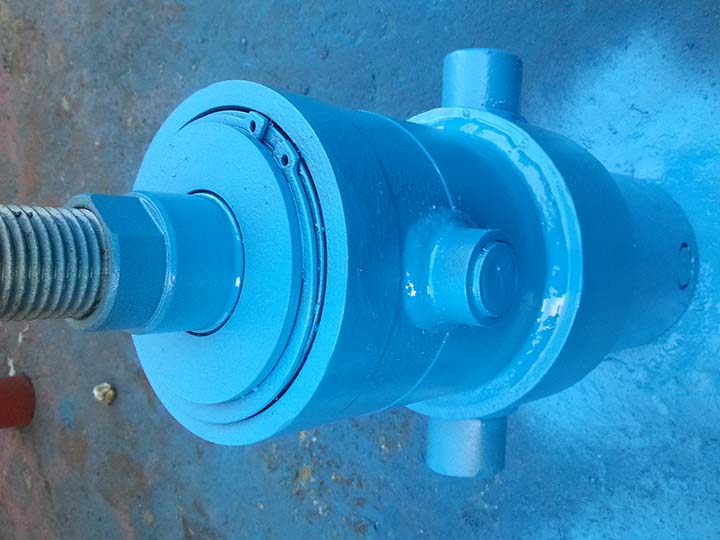
Release time:2023-11-08 08:12:21 Hits: Current position: Home > News
This article mainly introduces:
Estonia hydraulic cylinder,tilting furnace hydraulic cylinder manufacturer,tilting furnace hydraulic cylinder
(Estonia tilting furnace hydraulic cylinder,produced by Hebei Hengyu company)
tilting furnace hydraulic cylinder are widely used in Estonia,because of clever hydraulic energy conversion,simple structure and reliable operation,excellent temperature resistance.So our company has designed tilting furnace hydraulic cylinder for customers from Estonia.
The viscosity of the working oil used in the tilting furnace hydraulic cylinder is 29~74mm2/S, and ISO VG46 anti-wear hydraulic oil is recommended. Working oil temperature within the range of -20~80. C. When the ambient temperature and service temperature are low, the oil with lower viscosity can be selected.
When installing the tilting furnace hydraulic cylinder, the axial ends of the tilting furnace hydraulic cylinder cannot be fixed. Due to the effect of liquid pressure and thermal expansion in the tilting furnace hydraulic cylinder, there is axial expansion. If the two ends of the tilting furnace hydraulic cylinder are fixed, all parts of the tilting furnace hydraulic cylinder will be deformed. When disassembling the tilting furnace hydraulic cylinder, it is strictly forbidden to hammer the tilting furnace hydraulic cylinder and the piston surface, such as the tilting furnace hydraulic cylinder hole and the piston surface is damaged, do not allow sandpaper grinding, to use a fine oil stone carefully grinding. The clearance between the guide sleeve and the piston rod should meet the requirements.
Regular maintenance of the tilting furnace hydraulic cylinder includes: regular tightening, tilting furnace hydraulic cylinder fastening screws and gland screws, tilting furnace hydraulic cylinder piston rod stop adjustment screws, should be tightened once a month, tighten each screw evenly, and achieve the corresponding tightening torque. Replace the seal regularly, it is recommended to replace the seal of the tilting furnace hydraulic cylinder once a year. Clean regularly, the tilting furnace hydraulic cylinder is cleaned every other year, and the seals are replaced while cleaning.
Do not regularly check the damage of the chrome layer of the tilting furnace hydraulic cylinder: completely extend the tilting furnace hydraulic cylinder and carefully check whether there is any surface damage such as injury, strain, welding slag, such as the surface damage position, in the tilting furnace hydraulic cylinder block < 20cm, and the damage depth < 5mm, should be repaired in time to prevent long-term damage to the tilting furnace hydraulic cylinder seal. Welding slag is strictly prohibited on the surface of the tilting furnace hydraulic cylinder.
Servo cylinder control principle
The electro-hydraulic pulse servo cylinder is composed of a stepper motor, a three-position four-way servo valve, a mechanical feedback device (a wire carrier) and an oil lever. When the stepper motor gets a pulse signal, its output shaft rotates 1.5 or 3 degrees, the servo valve spool drives the wire to rotate at the same time, the valve spool moves and opens the reversing cylinder to output pressure oil, the piston moves and drives the lead screw to reverse rotate the valve spool back to the original position, and the servo valve stops output pressure oil in the center. At this time, the cylinder moves 0.1 or 0.2mm stroke, and the displacement and speed of the cylinder travel are determined according to the given value of the electrical pulse.
How to achieve hydraulic cylinder self-locking?
Hydraulic cylinder self-locking is divided into oil self-locking and mechanical self-locking. The oil self-locking is equipped with a valve to maintain pressure, so that the hydraulic oil of the cylinder does not return to the tank, and the oil chamber of the cylinder is filled with a certain pressure of oil. However, this pressure holding self-locking is not very safe and reliable, and the plunger will slowly return if there is a leak. Mechanical self-locking is to install a nut on the plunger of the cylinder, and when the cylinder rises to the required position, the nut on the cylinder plunger is rotated to the end, and the cylinder block is in contact, so that the plunger will be fixed to the required height. When it is necessary to relieve the pressure, screw the nut on again and let the plunger return to the position. This kind of cylinder has a special name, called self-locking hydraulic cylinder.